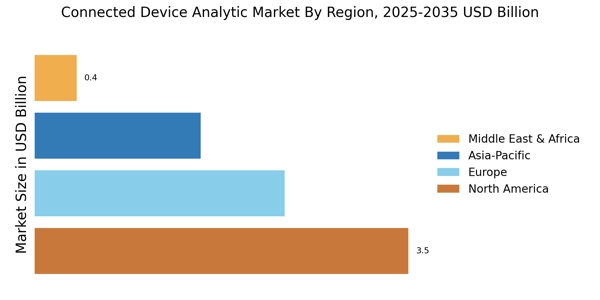The Connected Device Analytic Market is currently characterized by a dynamic competitive landscape, driven by rapid technological advancements and increasing demand for data-driven insights. Major players such as IBM (US), Microsoft (US), and Cisco (US) are strategically positioning themselves through innovation and partnerships, thereby enhancing their operational focus. IBM (US) emphasizes its cloud-based analytics solutions, while Microsoft (US) leverages its Azure platform to integrate IoT capabilities. Cisco (US) is enhancing its security offerings, which is crucial in a market where data privacy is paramount. Collectively, these strategies not only bolster their market presence but also shape a competitive environment that is increasingly reliant on technological integration and customer-centric solutions.
In terms of business tactics, companies are increasingly localizing manufacturing and optimizing supply chains to enhance efficiency and responsiveness. The market structure appears moderately fragmented, with a mix of established players and emerging startups. This fragmentation allows for diverse offerings, yet the collective influence of key players like Oracle (US) and SAP (DE) remains significant, as they continue to set industry standards through their comprehensive analytics platforms.
In August 2025, IBM (US) announced a strategic partnership with a leading telecommunications provider to enhance its IoT analytics capabilities. This collaboration aims to integrate advanced AI algorithms into their analytics suite, thereby improving real-time data processing and decision-making for clients. The strategic importance of this move lies in IBM's commitment to staying at the forefront of IoT innovation, which is essential for maintaining competitive advantage in a rapidly evolving market.
Similarly, in September 2025, Microsoft (US) launched a new suite of analytics tools designed specifically for smart cities. This initiative reflects Microsoft's focus on urban development and sustainability, aligning with global trends towards smarter infrastructure. The strategic significance of this launch is profound, as it positions Microsoft as a leader in providing solutions that address urban challenges, thereby expanding its market reach and reinforcing its commitment to sustainable development.
In October 2025, Cisco (US) unveiled a new cybersecurity framework tailored for connected devices, emphasizing the importance of security in analytics. This framework is designed to protect data integrity and privacy, which are critical concerns for businesses leveraging connected devices. The strategic relevance of this initiative cannot be overstated, as it not only enhances Cisco's product offerings but also addresses a growing market demand for secure analytics solutions.
As of October 2025, current competitive trends in the Connected Device Analytic Market are heavily influenced by digitalization, sustainability, and AI integration. Strategic alliances are increasingly shaping the landscape, allowing companies to pool resources and expertise to drive innovation. Looking ahead, competitive differentiation is likely to evolve from traditional price-based competition to a focus on technological innovation, reliability in supply chains, and the ability to deliver tailored solutions that meet specific customer needs.


















Leave a Comment